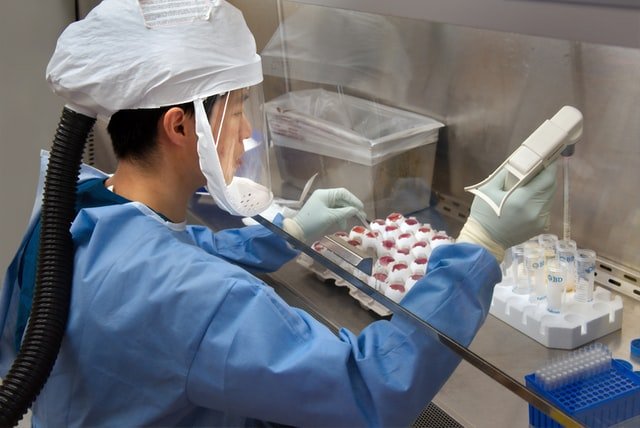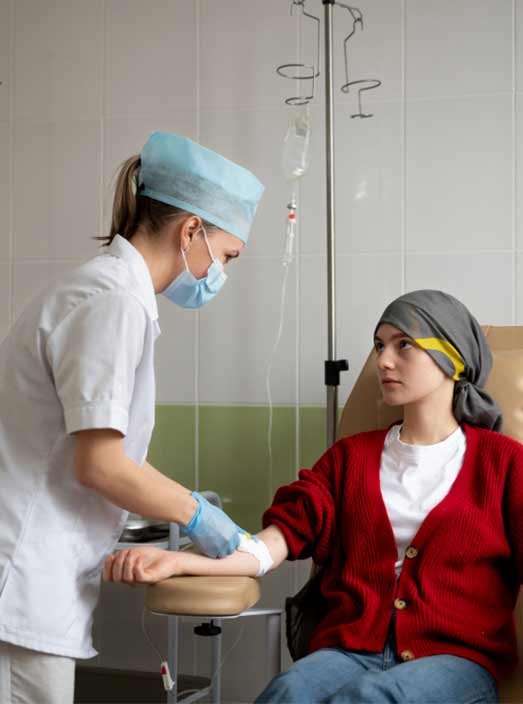Prostate Cancer
- Biotexus
- August 20, 2025
About the prostate
The prostate gland is a walnut-sized gland that sits behind the base of the penis, in front of the rectum, and underneath the bladder. The urethra, a tube-like canal that transports urine and sperm via the penis, is surrounded by it. The primary function of the prostate is to produce seminal fluid, a substance found in sperm that protects, supports, and transports sperm.
As people become older, their prostates continue to expand. When the urethra gets clogged, this can lead to a disease known as benign prostatic hypertrophy (BPH). BPH is a common ailment that comes with age, and it has not been linked to an increased risk of prostate cancer.
About prostate cancer
When healthy cells in the prostate begin to alter and grow out of control, a tumour forms. Tumors can be malignant or noncancerous. A malignant tumour is one that has the potential to develop and spread to other regions of the body. The term “benign tumour” refers to a tumour that can develop but not spread.
When compared to other kinds of cancer, prostate cancer is a bit different. This is due to the fact that many prostate cancers do not spread to other regions of the body fast. Some prostate tumours grow slowly and may not cause symptoms or complications for years, if at all. Prostate cancer may frequently be controlled for a long period, even if it has spread to other regions of the body. As a result, patients with prostate cancer, even those with advanced prostate cancer, may enjoy good health and a high quality of life for a long time. However, if the cancer is not properly treated with currently available therapies, it can produce symptoms such as discomfort and exhaustion, as well as mortality.
Risk Factors
Age : Prostate cancer risk rises with age, especially beyond the age of 50. Prostate cancer is diagnosed in around 60% of men aged 65 and over. Prostate cancer patients in their latter years may confront distinct problems, particularly in terms of therapy.
Race :
Prostate cancer is detected more frequently in black men and other men of African ancestry in the United States than in men of other races. Prostate cancer is more common in black men than in white men.
Location in North America or Northern Europe : The most common locations for prostate cancer are North America and northern Europe. Prostate cancer appears to be on the rise among Asians living in urbanised surroundings, such as Hong Kong, Singapore, and North American and European cities, particularly among individuals who live sedentary lifestyles and eat unhealthy foods.
Family history : Familial prostate cancer, or prostate cancer that runs in families, accounts for around 20% of all prostate cancers. A combination of shared genes and shared environmental or lifestyle variables causes this form of prostate cancer to emerge.
Eating habits: There has been no conclusive evidence that food and nutrition may cause or prevent prostate cancer. Many research that look at the association between particular eating habits and cancer imply that there is one. Obesity, for example, is linked to a variety of diseases, including prostate cancer, and a balanced diet is suggested to avoid weight gain.
Symptoms
While most cases of prostate cancer are asymptomatic, symptoms and indicators of prostate cancer might include:
- Frequent urination
- Weak or interrupted urine flow or the need to strain to empty the bladder
- The urge to urinate frequently at night
- Blood in the urine
- New onset of erectile dysfunction
- Pain or burning during urination, which is much less common
- Discomfort or pain when sitting, caused by an enlarged prostate
If cancer has spread outside of the prostate gland, symptoms and signs may include:
- Pain in the back, hips, thighs, shoulders, or other bones
- Swelling or fluid buildup in the legs or feet
- Unexplained weight loss
- Fatigue
- Change in bowel habits
Types of Treatment
Because most prostate cancers are discovered in their early stages, when they are still slow developing, treatment decisions are typically not rushed. During this time, it’s critical to discuss the risks and advantages of all of your treatment choices with your doctor, as well as when therapy should begin. This debate should also provide an update on the cancer’s current state:
- Whether you have symptoms or PSA levels are rising rapidly
- Whether the cancer has spread to the bones
- Your health history
- Your quality of life
- Your current urinary and sexual function
- Any other medical conditions you may have
Although your treatment options will be determined by these circumstances, there are some broad guidelines for treating prostate cancer according to stage. The common types of treatments used for prostate cancer are described below.
Active surveillance and watchful waiting
A doctor may prescribe active monitoring or careful waiting if prostate cancer is at an early stage, progressing slowly, and treating the cancer might cause more issues than the illness itself.
During active monitoring, the cancer is closely monitored for signs of exacerbation. If the cancer turns out to be worse, treatment will begin. Aggressive surveillance is usually preferred for patients with very low-risk or low-risk prostate cancer who can be treated with surgery or radiation therapy when there are signs of exacerbation.
Local treatments
Topical treatment eliminates cancer from specific areas of the body. Such treatments include surgery and radiation therapy. For early-stage prostate cancer, topical treatment can completely eradicate the cancer. If the cancer has spread outside the prostate, other types of treatment (such as medicines) may be needed to destroy cancer cells in other parts of the body.
Surgery : Surgery involves the removal of the prostate and some surrounding lymph nodes during an operation.
Radical (open) prostatectomy : The whole prostate as well as the seminal vesicles are surgically removed in a radical prostatectomy. It is also possible to remove lymph nodes in the pelvic region. Sexual function may be harmed as a result of this procedure. When feasible, nerve-sparing surgery enhances the likelihood that the patient will be able to preserve sexual function following surgery by avoiding surgical injury to the nerves that allow for erections and orgasm.
Robotic or laparoscopic prostatectomy : This procedure is less intrusive than a radical prostatectomy and may result in a faster recovery. A camera and tools are placed into the patient’s belly through tiny keyhole incisions. The robotic devices are then used by the surgeon to remove the prostate gland. The sexual and urinary side effects of robotic prostatectomy are comparable to those of a radical (open) prostatectomy.
Bilateral orchiectomy. Bilateral orchiectomy is the surgical removal of both testicles.
Transurethral resection of the prostate (TURP) : The most common reason for TURP is to ease the symptoms of a urinary obstruction, not to cure prostate cancer. A surgeon inserts a small tube with a cutting device called a cystoscope into the urethra and then into the prostate to remove prostate tissue while the patient is under complete anaesthesia, which is medicine that blocks pain perception.
Radiation therapy :
Radiation therapy is the use of high-energy rays to destroy cancer cells. Doctors who specialize in radiation therapy to treat cancer are called radiation oncologists. A radiation therapy regimen or plan usually consists of a specific number of treatments given over a set period of time.
External-beam radiation therapy : In vitro radiation therapy is the most common type of radiation therapy. Radiation oncologists use machines outside the body to focus the x-ray beam on the area of the cancer.
Brachytherapy : Brachytherapy or internal radiation therapy introduces the radiation source directly into the prostate. These sources, called seeds, emit radiation directly around the area in which they are located and can be left for a short time (high dose rate) or for a long time (low dose rate).
Intensity-modulated radiation therapy (IMRT) : IMRT is a type of external-beam radiation therapy that uses CT scans to form a 3D picture of the prostate before treatment.
Proton therapy : Proton therapy, also called proton beam therapy, is a type of external-beam radiation therapy that uses protons rather than x-rays.
Focal therapies :
Focal therapies are less invasive treatments that target tiny prostate cancers while leaving the rest of the prostate gland unaffected. These therapies, which are generally for low-risk or intermediate-risk prostate cancer, involve heat, cold, and other ways to treat cancer. Clinical studies are being conducted on focal treatments. The majority of them haven’t been authorised as routine treatments.
Systemic treatments :
Medication-based treatments are used to kill cancer cells. Medication can be administered through the circulation to cancer cells all throughout the body. Systemic treatment refers to the administration of a medicine in this manner.
The types of medications used for prostate cancer include:
- Hormonal therapy
- Targeted therapy
- Chemotherapy
- Immunotherapy
- Radiopharmaceuticals
- Bone-modifying drugs
Hormonal therapy:
Prostate cancer growth is promoted by male hormones called androgens, so lowering these hormone levels can slow the growth of the cancer. The most common androgen is testosterone. Hormone therapy is used to lower testosterone levels in the body by surgically removing the testicles, called surgical castration, or by taking drugs that turn off the function of the testicles, called medical castration.
Targeted therapy :
Targeted therapy is a treatment that targets a specific gene, protein, or tissue environment in the cancer that contributes to the growth and survival of the cancer. This type of treatment blocks the growth and spread of cancer cells and limits damage to healthy cells.
Chemotherapy :
Chemotherapy is the use of drugs to destroy cancer cells by blocking the growth, division, and formation of new cells. Chemotherapy can help patients with advanced or castration-resistant prostate cancer, as well as patients with newly diagnosed or castration-sensitive metastatic prostate cancer. Chemotherapy regimens or schedules usually consist of a specific number of cycles administered over a set period of time.
Immunotherapy :
Immunotherapy, also called biological therapy, aims to increase the body’s natural defenses to fight cancer. It uses materials made in the body or in the laboratory to enhance, target, or restore the function of the immune system.
Prevention
Dietary changes:
Currently, there is insufficient information to provide clear recommendations on the exact role of eating behavior in prostate cancer. Dietary changes may need to be made years before life to reduce the risk of developing prostate cancer later in life.
In some studies, regular intake of high-fat foods, especially animal fats, is associated with an increased risk of prostate cancer. However, there are no prospective studies showing that a diet high in animal fat increases the risk of prostate cancer. A prospective study examines people on a high-fat or low-fat diet and then measures the total number of people diagnosed with prostate cancer in each group.
A diet high in vegetables, fruits, legumes and peas can reduce the risk of prostate cancer. It is unknown which nutrient is the direct cause. Lycopene, a nutrient found in tomatoes and other vegetables, has been shown to have a lower risk of prostate cancer, but data do not prove a link between lycopene and cancer prevention.



















